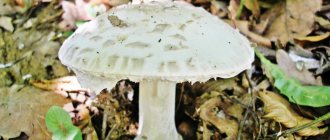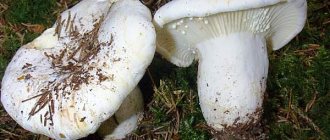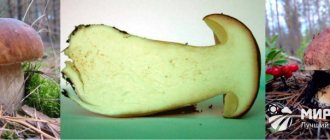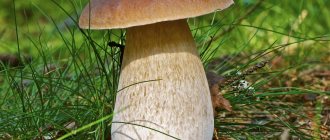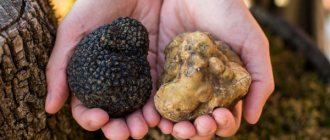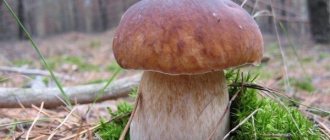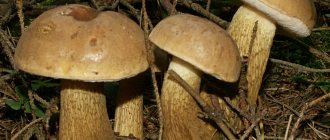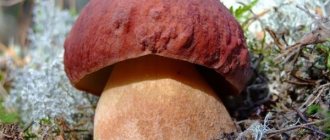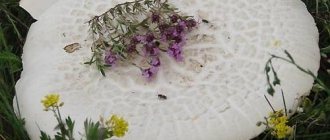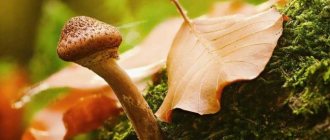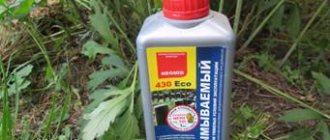Valui mushrooms (Russula foetens)
The cunning valui (Russula foetens), until it has completely emerged from the ground, looks like both boletus and russula, but as soon as it appears in full, it can easily be mistaken for boletus. This productive lamellar mushroom from the Strophariaceae family has a bitter taste, but its crispy flesh is excellent in pickling, and therefore the strong valui deservedly takes its place in the mushroom basket.
Description
Young mushrooms have a round, ocher-colored cap that barely peeks out from under the ground, covered with abundant mucus, and glossy in dry weather. Over time, the mushroom rises above the soil on a fragile white or brownish stalk, up to 12 cm high. The stalk is thick in the center, in adult specimens it is loose, with voids, and easily breaks off at the slightest shock.
The cap of the old valuu becomes yellowish-brown or brown and opens, reaching a diameter of 15 cm, later it takes on a prostrate shape and cracks along the edge. If you look closely, you can see thin lines or grooves on the smooth skin, directed from the sunken center to the curved edges. By picking up the loose edge, the skin can be easily removed, which makes cleaning much easier.
The plates are whitish-cream, then yellowish, secrete droplets of clear juice, then dry out in brown spots. The pulp is white, tight, with a burning-bitter taste. The smell is special, reminiscent of celery, sometimes unpleasant, similar to spoiled butter.
It is worth collecting young fruiting bodies whose caps are spherical and have not yet fully opened. After cleaning and soaking, such mushrooms are used for pickles.
What inedible mushrooms need to be distinguished from?
Many members of the genus are not only inedible, but also highly toxic. Therefore, mushroom pickers should know their distinctive features.
Inverted
Poisonous variety. Its representatives can be mistaken for funnel talkers. The cap can be spread out or take the shape of a shallow funnel. The surface is dry, matte, painted orange-brown or brick. The leg is dry, finely pubescent.
The distinctive feature of the inverted species is the wavy edges of the cap and a depression shaped like the spout of a jug. The pulp of these mushrooms smells like frozen orange juice with hints of bergamot.
Waxy
The shape of the cap is variable: initially it is convex with a tubercle in the middle and tucked edges, later the cap becomes flattened, the tubercle almost disappears, but the edges remain tucked.
In adult talkers, the cap takes on a funnel shape and the edges become wavy. A characteristic feature of this species is a white waxy coating on the surface of the cap. The brownish base shade shows through underneath. As the mushroom ages, this coating may crack, forming a marbled pattern.
Depending on the age of the fetus, the leg can be painted white or ocher. There is a so-called frosty coating on its surface. A pleasant spicy aroma emanates from the pulp of the waxy talker.
Places of distribution and time of collection
Valui are found in abundance in deciduous or mixed forests of temperate climates - singly or in groups. But most often, the productive species settles in large clearings, forming numerous colonies under birch, oak, and aspen trees. The mycelium also grows, forming mycorrhiza under coniferous trees, usually under pine. Favorite places of growth are wet lowlands, shady, damp corners of the forest.
Another person will not bend over, but will pry the edge of the cap with his foot, pick it off, examine the plates and, making sure that it is not a porcini mushroom in front of him, but a low-value bitter valuu, will pass by. But a real connoisseur will collect a bucket of valuev, pickle it and enjoy the appetizing snack.
The first wave of collection occurs in mid-summer and already from the beginning of July, after generous summer rain, slimy yellow caps can be found. Fruiting ends in late autumn - early or mid-October.
Where they grow, in what forests and how to collect
Representatives of the species are distributed throughout the territories of Central and Western Europe, Central Asia, the Caucasus and the northern part of Russia. In the central part of the Russian Federation they grow selectively.
The mushroom season begins in June and continues until October. As a rule, myceliums grow in colonies. Representatives of the species prefer acidic forest soils of coniferous and mixed plantings. Especially a lot of mushrooms can be found under spruce, pine, oak, beech and chestnut trees.
Myceliums do not tolerate heat and lack of rain very well. Therefore, you should go searching during the rainy season.
The rules for collecting these mushrooms do not go beyond standard recommendations:
- the fruits should be twisted, not cut, so as not to accidentally damage the mycelium;
- It’s better to go on a “quiet hunt” in the morning, when there is still dew on the grass.
Remember!
The basic rule of a mushroom picker is: “It is better to leave doubtful specimens in the forest.”
False values and doubles
Valuis are similar to many famous mushrooms - russula, boletus and even white mushrooms. Such confusion is not dangerous and, having sorted it out, you can prepare food from all these types, processing each separately. But the situation becomes much worse, if, due to inexperience, the light-colored caps of valuevs are confused with the yellow fly agaric, which is extremely poisonous, or hebeloma adhesive, which can cause digestive disorders, suffocation and nervous phenomena.
Amanita straw yellow
Amanita straw yellow
The convex caps are small, up to 12 cm in diameter, light yellow or brownish, later becoming flat, the skin is smooth, often with white dots or warts. The leg is tall, up to 15 cm high, cream-colored, tuberously thickened at the base; remains of the vulva can be seen. The cuff is poorly developed, in the form of thin films.
The plates are creamy, sometimes yellowish, and frequent. The pulp is tasteless, loose, with a barely audible radish smell. Grows in coniferous and deciduous-coniferous forests, preferring sandy soils, from late spring to early autumn. The fly agaric is distinguished by its smell, the presence of warts or spots on the cap, a thickened base and the soft structure of the pulp.
Poisoning does not have an immediate effect - it can take up to 48 hours; characteristic symptoms are dizziness, hallucinations, and disruption of the gastrointestinal tract. If you experience any such symptoms, you should immediately consult a doctor.
Gebeloma adhesive (false valui)
Gebeloma adhesive (false valui)
The fruiting bodies are light, with a hemispherical cap, which later becomes flat. The skin is creamy white, sometimes light brown, covered with mucus, then smooth and fibrous. The leg is smooth, up to 8 cm high, hollow, the surface is mealy or covered with scales.
The plates are creamy-yellowish, with a brown tint in older specimens. The pulp is fleshy, creamy or brownish, very bitter with a characteristic strong odor reminiscent of radish or horseradish. It is the pungent odor, as well as the scales on the stalk, that are the distinctive features of this poisonous mushroom.
Hebeloma adhesive grows in meadows and forest clearings under trees of various species, often in large families, forming peculiar rings. You can see these mushrooms from late summer until severe frosts, and sometimes during thaws.
A very poisonous species causes digestive disorders - nausea, vomiting, gas formation, painful colic; nervous phenomena - headaches, weakness, tingling in the fingers. In case of hebeloma poisoning, immediate medical attention is required.
Edible species are distinguished from valuei by the following characteristic features:
- porcini mushrooms and boletus mushrooms have tubes, and value mushrooms have plates;
- almond russula is characterized by the aroma of nuts or bitter almonds;
- Morse's russula has ocher-colored plates with lilac-brown edges, a weak, nutty odor.
White mushrooms
boletus
Russula almond
Russula Morse
History of the name
The semi-white mushroom was first described by Elias Magnus Fries, a prominent 19th-century mycologist who placed the mushroom in the genus Boletus.
The Latin epithet impolitum (meaning "rough") is a reference to the rustic, unfinished or unpolished appearance of the cap, which is initially covered with a thin thread-like covering when viewed under a magnifying glass. The taxonomic position of the species has long remained uncertain, with various authors in the past placing it in different genera, including the now abandoned genera Tubipora and Versipellis. This mushroom was included in the genus Hemileccinum in 2008, which has distinct characteristics from the genus Boletus. The genus includes species with macroscopic and microscopic characteristics intermediate between Boletus, leccinum and Xerocomus s.str. The validity of this new genus was supported by phylogenetic studies, which demonstrated the effective evolutionary distance between Hemilecine, Boletus and Xerocomus. Subsequent work confirmed the monophyly of the genus, which currently includes only two European species: Hemileccinum impolitum and Hemileccinum depilatus.
Beneficial features
Although many consider valui to be an unworthy, inedible mushroom, when properly prepared, they are not only tasty, but also healthy. The fruiting bodies contain a lot of protein, which gives them healthy nutritional value and makes them suitable for consumption by people who want to lose weight, as well as during intense physical activity. Proteins are close in composition to meat proteins and include essential amino acids - tyrosine, leucine, arginine.
The presence of vitamins and minerals has a positive effect on metabolic processes, the functioning of hematopoietic organs, and the nervous system. The substance ergothioneine is found in tissues, which has pronounced antioxidant properties, inhibits the development of cancer cells, and has an anti-inflammatory and rejuvenating effect.
Moderate inclusion of mushroom dishes in food will help eliminate cholesterol, normalize blood sugar levels, stabilize blood pressure, relieve fatigue syndrome, and give strength and vigor.
Benefit
The presented variety of mushrooms boasts a large list of beneficial properties.
- ß-glucans present in the composition strengthen the immune system and fight malignant tumors.
- Mushroom melanin is one of the strongest antioxidants.
- Nicotinic acid strengthens the heart muscle and the walls of blood vessels.
Tinctures from Polish mushrooms are used in folk medicine to treat skin ailments and gastrointestinal diseases. In addition, this product improves brain activity and eliminates chronic fatigue.
Contraindications for use
Fungal tissues are capable of absorbing not only valuable minerals - manganese, calcium, phosphorus, but also heavy metal salts, as well as toxins, turning into an inedible or even harmful product. When picking mushrooms, you need to make sure that the area is clean and away from industrial enterprises, busy roads and landfills.
Insufficiently soaked or improperly prepared valui can cause discomfort in the stomach, colic, and nausea. People who are susceptible to hypertension, gastritis, hepatitis, pancreatitis or gallbladder dysfunction should not overuse any mushroom dishes.
Harm
Despite all the benefits, valuuy can still cause harm to the body. Which one?
Unfortunately, in addition to vitamins and minerals, these mushrooms contain a substance that has an irritating effect. It is this substance that gives the unprocessed mushroom its bitter taste. In order to save the bull from such an unpleasant moment, you need to soak it in several waters for a long time.
The mushroom, like other representatives of the species, contains chitin. This substance is poorly absorbed by the body and digested even worse. This limits the consumption of mushrooms for people who have problems with the gastrointestinal tract.
You should not pick mushrooms near roads, industrial facilities, or trash cans. The fungus very quickly absorbs harmful substances from the soil and air and transfers them into the body.
Important! Eating such mushrooms fresh can cause significant damage to the body. It has an irritating effect on the mucous membrane of the digestive tract, which will lead to attacks of vomiting and nausea.
Recipes for cooking dishes and preparations
Walui (bulls)
Valui, due to its bitterness, requires long soaking or blanching before cooking. It is best to prepare pickles from these mushrooms; in this form they turn out exceptionally tasty, satisfying and healthy.
Soaking and Blanching
For soaking, the peeled fruiting bodies are placed in a wooden or enamel container and filled with fresh, slightly salted water for at least three days. The mass is pressed down on top with a circle and pressure, the water is changed several times a day.
To better remove the bitter taste and preserve the crispy structure, you can acidify the brine, then take 100 g of salt and 20 g of citric acid per 10 liters of water, soak the valui in the same way, changing the brine twice a day.
Blanching is used instead of soaking to speed up preparation. Immerse the mushrooms for 20 minutes in boiling brine prepared at the rate of 100 g of salt per 10 liters of water, then strain and rinse with cold water.
Valui in hot pickling
For 5 kg of mushrooms take: 10 tablespoons of salt, several bay leaves, black and allspice, dill seeds, black currant leaves, and other spices to taste.
Two and a half glasses of water are poured into the container, salt is added and brought to a boil, after which the chopped fruit bodies are immersed, which will soon release juice. As soon as the brine boils, remove the foam, add spices and, stirring, boil for 20 minutes. External signs of readiness are that all the pieces settle to the bottom and the liquid becomes clearer. The workpiece is cooled and placed in jars, filled with brine and closed. The snack is ready in 45–50 days. Store in the basement or in the refrigerator at a temperature not exceeding +6°C.
Valui in sour cream
For 1 kg of mushrooms take: 2 tablespoons of butter, 1 glass of sour cream, 1 small onion, dill, ground black pepper, salt.
Fruit bodies, previously soaked in acidified and salted water, are doused with boiling water and cut into pieces. Place one tablespoon of butter in a container, add mushrooms, salt and simmer under the lid until they absorb the liquid. Then mix everything, add another spoonful of oil, finely chopped onion and, shaking and stirring, fry over medium heat. Once the mushrooms are ready, add sour cream, dill, pepper, salt, bring to a boil and serve.
Video about value mushrooms.
The appetizing, beefy Valuy has received several popular nicknames - he is a bull, and a kulak, and a kubar, and a kulbik. The presence of so many affectionate names is a sign of attentive attention and general recognition of the value of the species. A knowledgeable mushroom picker will not ignore the light-colored caps of the value, and many specifically look for elastic young mushrooms covered with thick mucus, rightfully considering them the best for pickles and marinades.
Application
The answer to the main question about the Polish mushroom: “is it edible or not?” - of course, edible. And moreover, it is very tasty, since it practically does not boil down and retains its taste and beneficial properties after heat treatment.
In cooking
Since such a wonderful Polish mushroom, how to cook it? Chefs from different countries handle Polish mushrooms extremely skillfully: they make soups, sauces, and gravies from it; salted for the winter, fried, baked, stuffed, grilled, etc. Processed mushrooms are included in the filling for pizza or a variety of pies.
One of the restrictions is that you cannot eat these mushrooms raw. It is imperative to clean away places where worms have eaten and “forest debris”. It is advisable to keep the mushrooms in water with salt before processing in order to further disinfect the product.
It is important not to forget that the shelf life of raw mushrooms is no more than a day, otherwise they will begin to rot and will no longer be suitable for food. Collect and either boil, fry, or process in any other convenient way as soon as possible.
In medicine
Sick people can prepare soup from Polish mushrooms - it has the same healing “magic” as chicken soup. Dishes made from this product help renew the body, digestion processes and blood formation.
